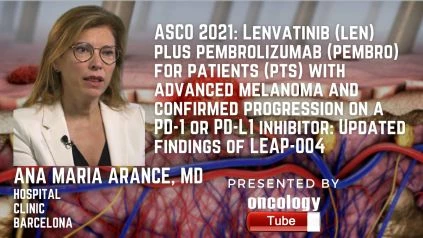Ana Maria Arance, MD from the Hospital Clinic Barcelona speaks about ASCO 2021 Abstract – Lenvatinib (len) plus pembrolizumab (pembro) for patients (pts) with advanced melanoma and confirmed progression on a PD-1 or PD-L1 inhibitor: Updated findings of LEAP-004.
Link to Abstract:
https://meetinglibrary.asco.org/record/195985/abstract
Background information:
In patients with unresectable stage III-IV melanoma with confirmed PD on a PD-(L)1 inhibitor administered alone or in combination, preliminary data from the open-label, single-arm, phase 2 LEAP-004 trial (NCT03776136) revealed that len and pembro in combination exhibited promising effectiveness and acceptable safety. ORR was 21.4 percent with a 6.3-month median DOR in patients with PD who had previously received anti–PD-1 + anti–CTLA-4 therapy; ORR was 31.0 percent in patients who had previously received anti–PD-1 + anti–CTLA-4 therapy. Updated data from LEAP-004 is presented, as well as further ORR subgroup analysis.
Methodologies:
Eligible patients with PD verified by iRECIST within 12 weeks of the last dose of a PD-(L)1 inhibitor administered alone or in combination with anti–CTLA-4 or other treatments for two doses were given len 20 mg/d once daily plus 35 doses of pembro 200 mg Q3W until PD or unacceptable toxicity. ORR per RECIST v1.1 is the primary end goal, as determined by a blinded impartial central review (BICR). PFS and DOR per RECIST v1.1 by BICR, OS, and safety are secondary end goals. ORR was calculated for patients with PD on prior anti–PD-1 + anti–CTLA-4, patients whose only prior anti–PD-(L)1 was in the adjuvant setting, patients with primary resistance (best response of SD or PD to prior anti–PD-(L)1 in the advanced setting), and patients with secondary resistance (best response of CR or PR on prior anti–PD-(L)1 in the advanced setting).
The following are the outcomes:
A total of 103 points were collected. The median age of the patients was 63 years old, and 68.0 percent had stage M1c/M1d disease, 55.3 percent had LDH > ULN (20.4 percent 2 ULN), 58.3 percent had two previous therapies, 94.2 percent had advanced disease therapy, and 32.0 percent had BRAF MEK inhibition. 17.5 percent of patients were still receiving study medicine after a median follow-up of 15.3 months (range 12.1-19.0). Although the number of CRs grew from 2 to 3, the ORR by BICR stayed at 21.4 percent (95 percent CI 13.9-30.5). The DCR rate was 66.0 percent. The median DOR rose to 8.2 months, with a 37.2 percent KM estimate for DOR 9 months. ORR was 33.3 percent in patients with PD who had previously received anti–PD-1 + anti–CTLA-4 (n = 30), 18.2 percent in patients who had only received anti–PD-1/L1 as an adjuvant (n = 11), 22.6 percent in patients who had primary resistance (n = 62), and 22.7 percent in patients who had secondary resistance (n = 22). In the overall population, the median (95 percent CI) PFS and OS were 4.2 months (3.8-7.1) and 14.0 months (95 percent CI 10.8-NR), respectively; 12-month PFS and OS estimations were 17.8% and 54.5 percent. The following are the rates of treatment-related adverse events: 96.1 percent had any grade, 45.6 percent had grade 3-4, 1.0 percent had grade 5 (lower platelet count), 7.8 percent had len and/or pembro discontinued, and 56.3 percent had len dose reduced.
Final Thoughts:
In patients with advanced MEL and confirmed progression on a prior PD-(L)1 inhibitor, including those with PD on anti–PD-1 + anti–CTLA-4 therapy, the combination of len and pembro continues to show clinically meaningful, durable responses, regardless of primary or secondary resistance to prior anti–PD-(L)1 therapy. The safety profile of len + pembro was consistent with previous research. These findings support the use of len + pembro as a treatment option for this underserved group.
NCT03776136 is the number for the clinical trial.

